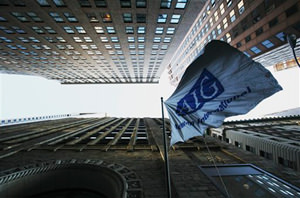Billions Dished Out in the Shadows
We've already given AIG a total of $170 billion -- an amount that dwarfs the $75 billion allocated to helping those millions of homeowners facing foreclosures. And more will be thrown down the AIG rat hole because President Barack Obama is blindly following the misguided advice of his top economic advisers, who insist that AIG is too big to fail.
This is crazy! Forget the bleating of Rush Limbaugh; the problem is not with the quite reasonable and, if anything, underfunded stimulus package, which in any case will be debated long and hard in Congress. The problem is with what is not being debated: the far more expensive Wall Street bailout that is being pushed through — as in the case of the latest AIG rescue — in secret, hurried deal-making primarily by the unelected secretary of the treasury and the chairman of the Federal Reserve.
Six months ago, we taxpayers began bailing out AIG with more than $140 billion, and then it went and lost $61.7 billion in the fourth quarter, more than any other company in history had ever lost in one quarter. So Timothy Geithner and Ben Bernanke huddled late into the night last weekend and decided to reward AIG for its startling failure with 30 billion more of our dollars. Plus, they sweetened the deal by letting AIG off the hook for interest it had been obligated to pay on the money we previously gave the company.
AIG doesn’t have to pay the 10 percent interest due on the preferred stock the U.S. government got for the earlier bailout funds because that interest will now be paid out only at AIG’s discretion, which means never. The preferred stock, which got watered down, carried a cumulative interest, meaning we taxpayers would have recaptured some money if the company ever got going again, but that interest obligation was waived in the new deal.
We’ve already given AIG a total of $170 billion — an amount that dwarfs the $75 billion allocated to helping those millions of homeowners facing foreclosures. And more will be thrown down the AIG rat hole because President Barack Obama is blindly following the misguided advice of his top economic advisers, who insist that AIG is too big to fail.
“AIG provides insurance protection to more than 100,000 entities, including small businesses, municipalities, 401(k) plans and Fortune 500 companies who together employ over 100 million Americans,” the joint Treasury Department and Fed statement declared while insisting that for that reason, plus the “systemic risk AIG continues to pose and the fragility of markets today, the potential cost to the economy and the taxpayer of government inaction would be extremely high.”
What about the cost of inaction by Treasury and the Fed before this meltdown? If AIG were so important to the American economy, shouldn’t government regulators have been looking more closely at its activities? They couldn’t then, and even now they don’t understand what AIG has been up to, because the company was allowed to operate in an essentially unregulated global economy in which multinational corporations have their way. As the Treasury/Fed statement concedes: “AIG operates in over 130 countries with over 400 regulators and the company and its regulated and unregulated subsidiaries are subject to very different resolution frameworks across their broad and diverse operations without an overarching resolution mechanism.”
Oh, really? And you’re discovering that only now, when you’re making us bail AIG out? It wasn’t that long ago that a couple of hustlers operating out of an AIG office in London were going wild making money off selling insurance on credit default swaps that no one could understand, but the company execs loved those huge profit margins. To challenge their maneuvering, as some in Congress attempted, was said by their defenders, including Geithner, to put them at an unfair disadvantage in the world market. Ignorance was bliss … until the bubble burst.
This was all belatedly conceded by Bernanke in his Senate testimony on Tuesday: “AIG exploited a huge gap in the regulatory system. There was no oversight of the Financial Products division. This was a hedge fund, basically, that was attached to a large and stable insurance company, made huge numbers of irresponsible bets — took huge losses. There was no regulatory oversight because there was a gap in the system.”
AIG used to be in the conventional insurance business, covering identifiable risks it knew something about, until it took advantage of deregulation and a lack of government surveillance to come up with contrived new financial products. Even Maurice Greenberg, the man who built AIG from the ground up over a span of 40 years before he was forced out amid corruption charges in 2005, admits that he didn’t understand the newfangled financial gimmicks that the company was peddling. This week, claiming he too was swindled, Greenberg sued in federal court, charging the AIG execs who forced him out with “gross, wanton or willful fraud or other morally culpable conduct,” over the credit default swap portfolio that was part of his settlement.
U.S. taxpayers now have ownership of almost 80 percent of AIG, but with the company’s once solid traditional insurance business now suffering a steep loss of consumer confidence, it’s not likely that even the formerly healthy parts of the company will be worth much. What we have here is all pain and no gain for the taxpayers roped into this debacle, which is proving to be the story of the entire banking bailout.
Your support matters…Independent journalism is under threat and overshadowed by heavily funded mainstream media.
You can help level the playing field. Become a member.
Your tax-deductible contribution keeps us digging beneath the headlines to give you thought-provoking, investigative reporting and analysis that unearths what's really happening- without compromise.
Give today to support our courageous, independent journalists.






You need to be a supporter to comment.
There are currently no responses to this article.
Be the first to respond.